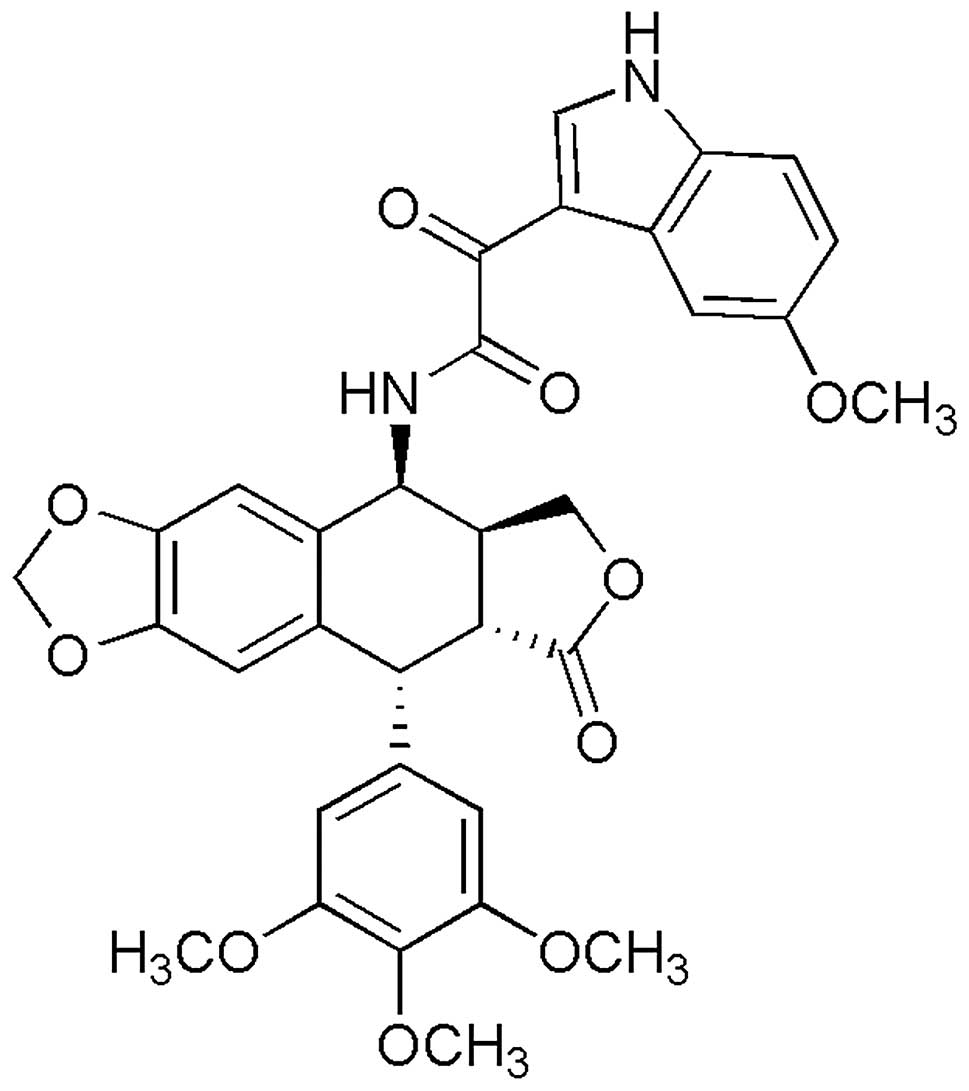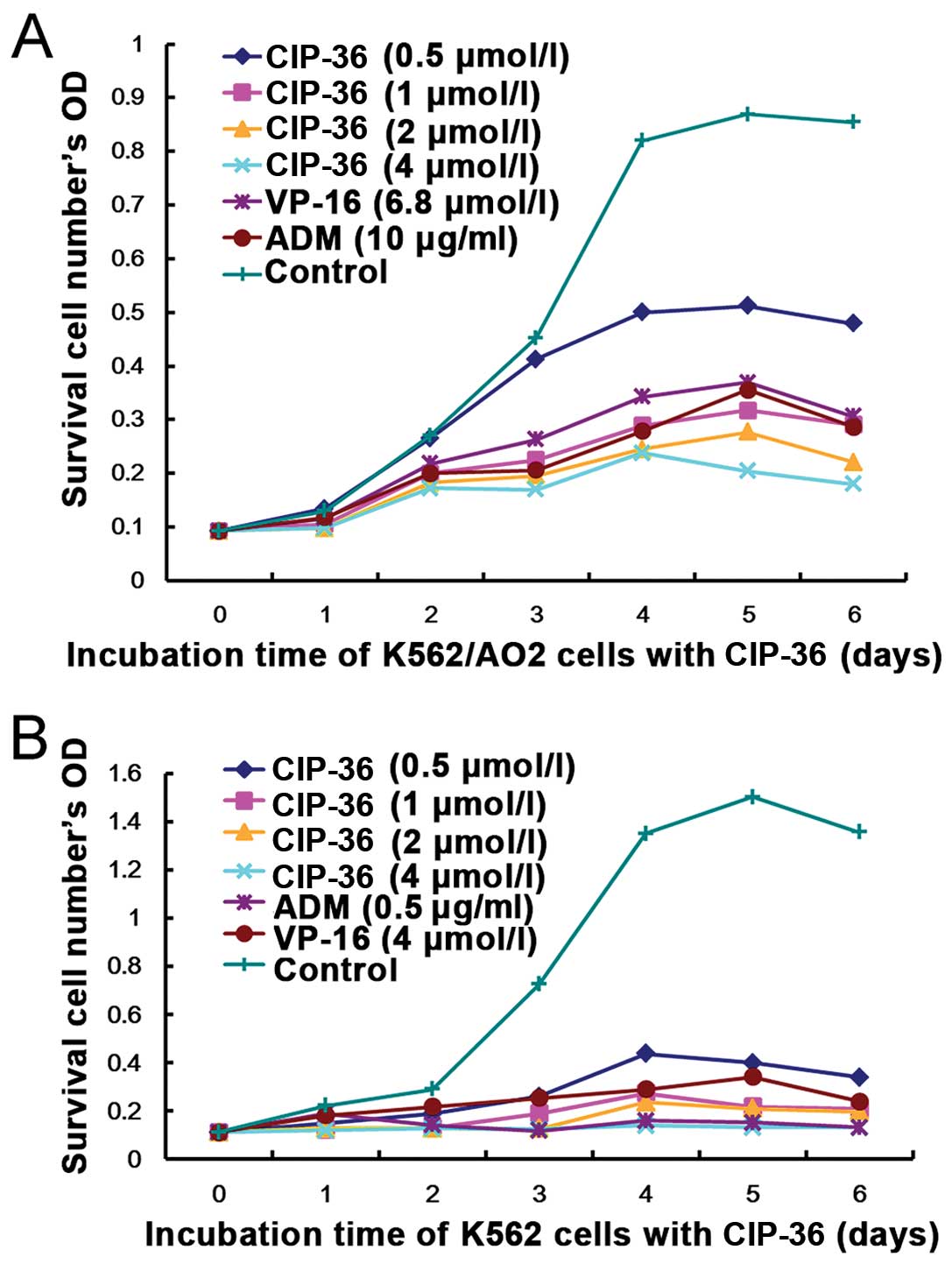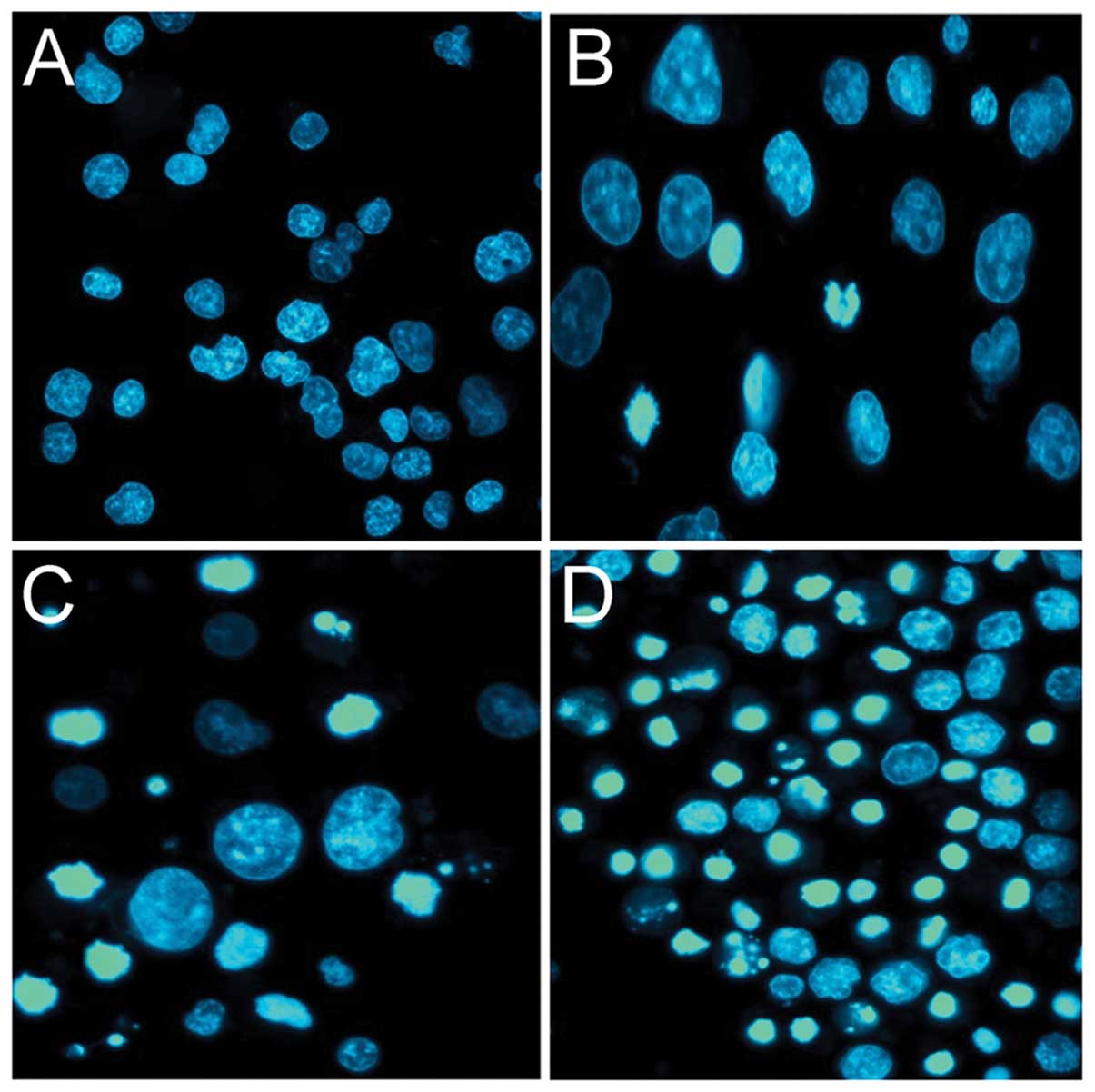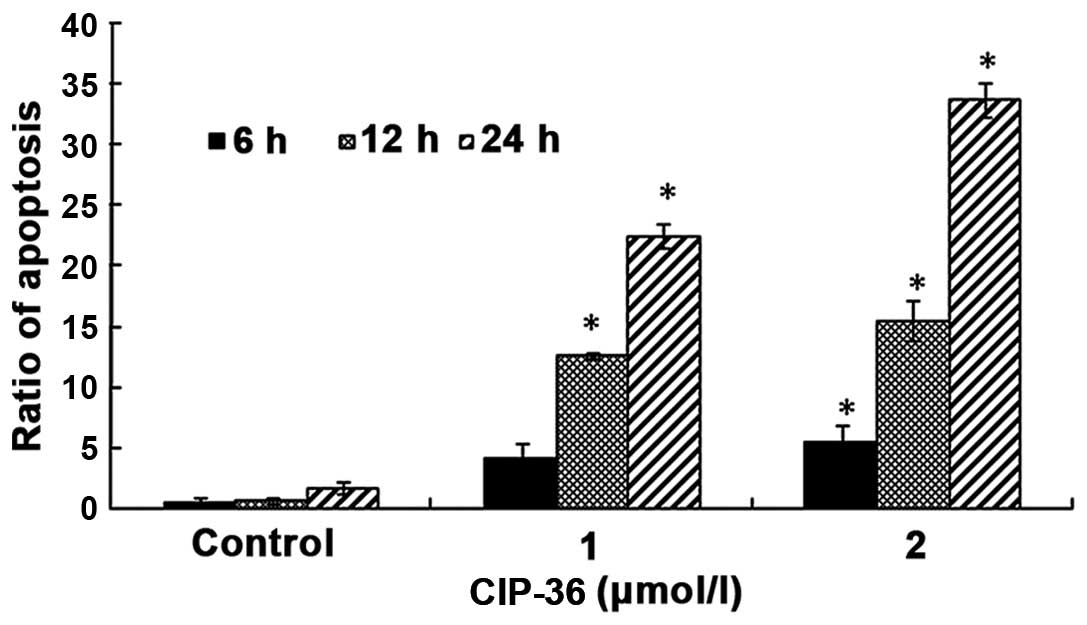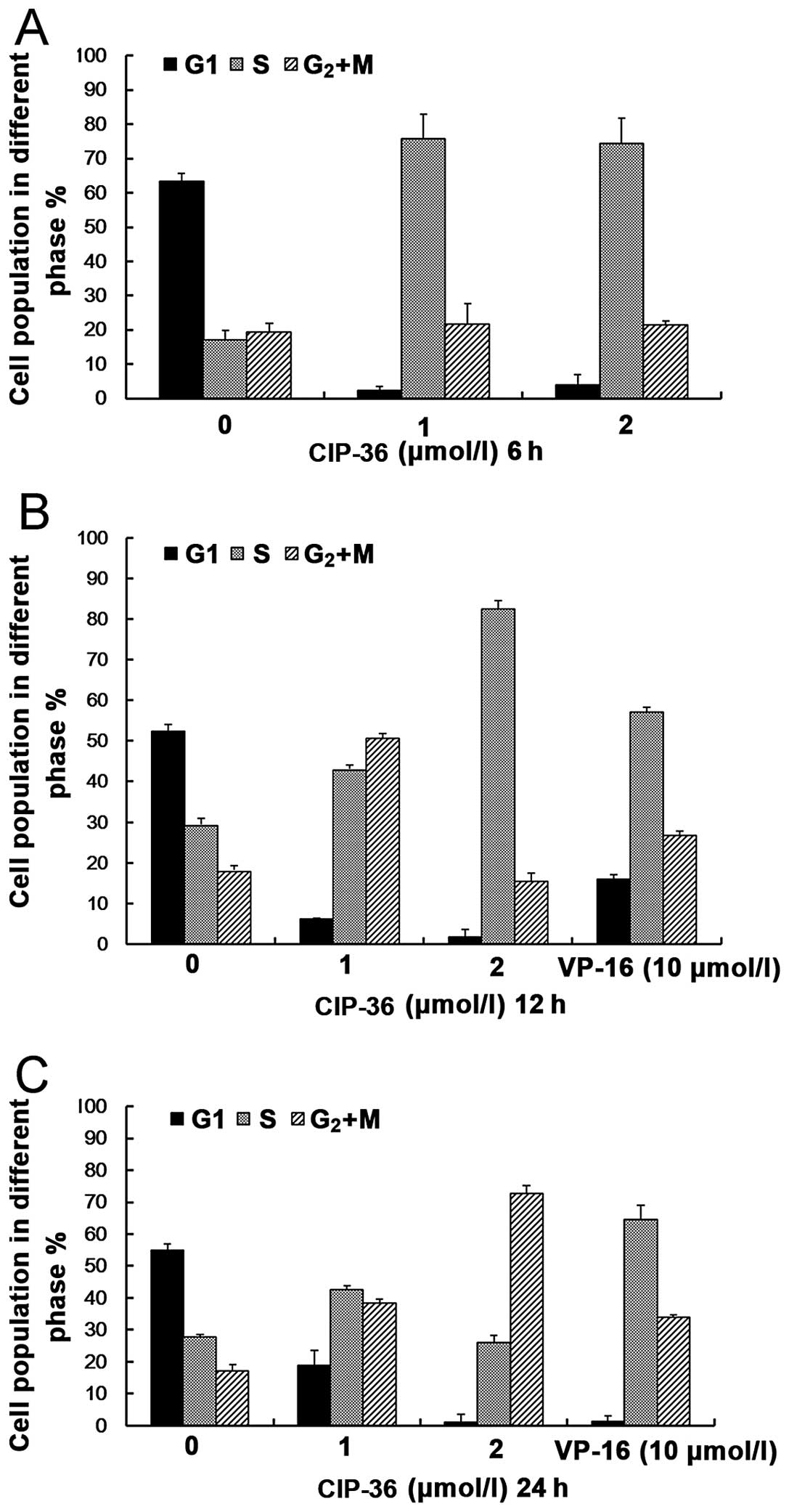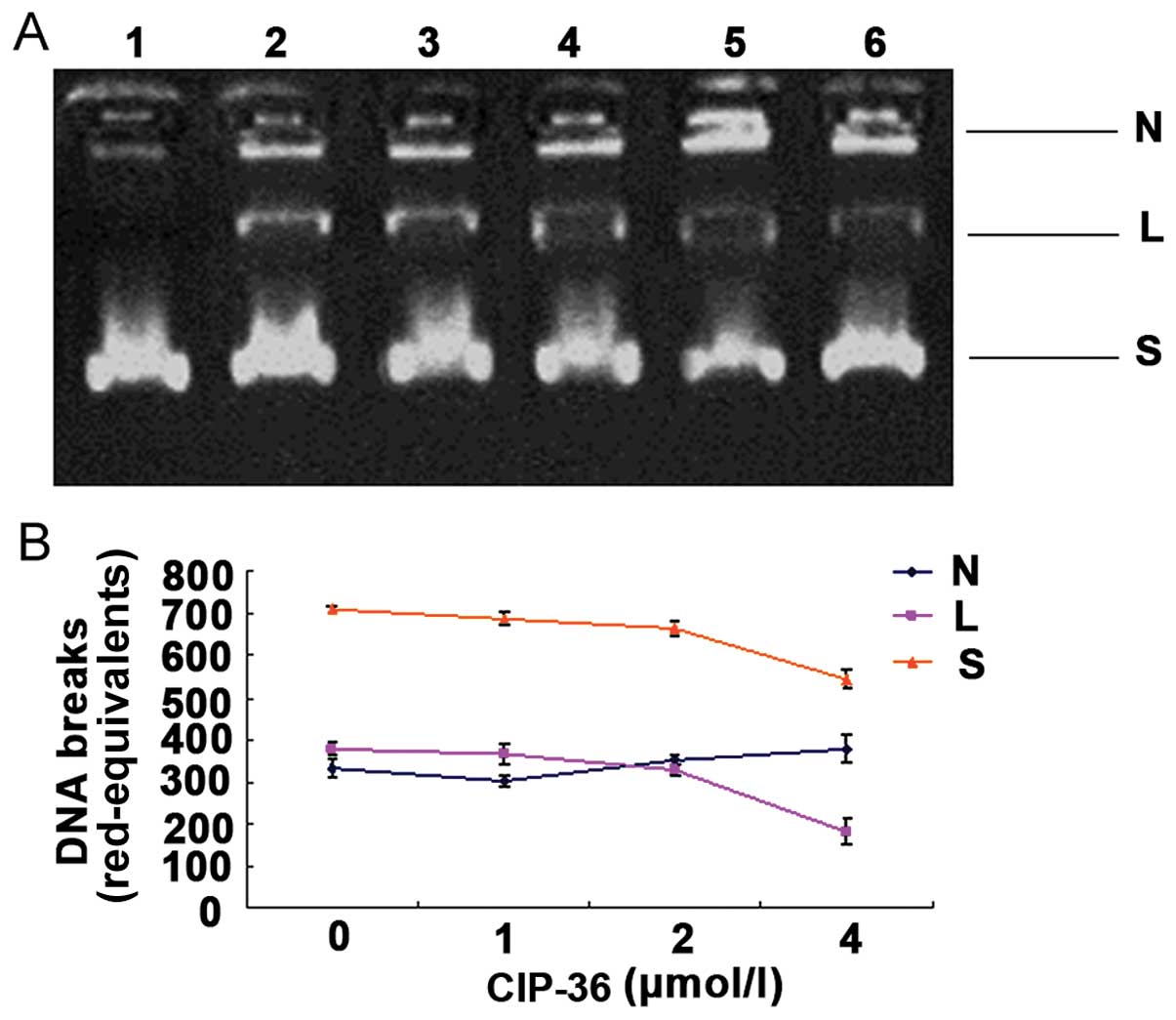CIP-36, a novel topoisomerase II-targeting agent, induces the apoptosis of multidrug-resistant cancer cells in vitro
- Authors:
- Published online on: January 14, 2015 https://doi.org/10.3892/ijmm.2015.2068
- Pages: 771-776
Abstract
Introduction
Multidrug resistance (MDR), a cross-resistance of cancer cells to seemingly unrelated drugs, such as anthracyclines vinca alkaloids (doxorubicin and daunorubicin), epipodophyllotoxins, (vincristine and vinblastine) and taxanes (taxol and taxotere), is a major clinical concern in the treatment of human cancers with conventional chemotherapeutic drugs (1).
Topoisomerase II (Topo II) poisons widely used in clinical practice, such as etoposide, adriamycin (ADM) and their analogues often induce dose-limiting toxicity and MDR, resulting in treatment failure after the initial effective therapy (2,3). Therefore, increasing research has focused on the development of novel Topo II-targeting drugs, with the aim to overcome current hurdles (4–6).
Although reversal agents have been assessed for their efficacy against cancers with MDR, the majority have shown little or no therapeutic potential due to their high toxicity in vivo at the doses required to reverse MDR, as observed with verapamil (7). Over the past few years, podophyllotoxin derivatives have been widely used as cancer chemotherapeutic agents (8). For instance, etoposide, a low toxicity semisynthetic podophyllotoxin analogue, has been utilized for the treatment of a broad spectrum of tumors, for its Topo II-targeting properties (9,10). The suppression of Topo II activity by Topo II-targeting drugs, such as etoposide and ADM, can lead to double-stranded DNA breaks (11,12). In addition, other newly developed derivatives (e.g., NPF and GL-331) (13–15) which have displayed better pharmacology profiles are currently being evaluated in clinical trials (16). However, compared to many previously described drugs, they have not shown sufficient potency in the treatment of cancers with MDR. Recently, a novel podophyllotoxin derivate, CIP-36 (Fig. 1), was synthesized in our laboratory and presented the advantages of effectiveness, stability and low toxicity. In this study, we aimed to investigate CIP-36 for its effects on cancer cells with MDR. In vitro enzymatic assay demonstrated the effectiveness of CIP-35 in inhibiting Topo IIα activity. CIP-36 inhibited the proliferation of multiple cancer cells, including multidrug-resistant K562/A02 cells, suggesting that it has the potential for use as an optional chemical agent in the treatment of cancers with MDR.
Materials and methods
Anticancer drugs
CIP-36 (purity >98%) was synthesized in the laboratory of Professor Hong Chen by Dr Pengfei Yu. Its molecular structure is illustrated in Fig. 1. ADM was purchased from Shenzhen Wanle Pharmaceutical Co., Ltd. (Shenzhen, China) and etoposide (VP-16) was from Jiangsu Hengrui Medicine Co., Ltd. (Jiangsu, China).
Cells
The human leukemia cell line, K562, and the ADM subline, K562/A02, were obtained from the Institute of Hematology and Blood Disease Hospital, Chinese Academy of Medical Sciences and Peking Union Medical College (Beijing, China). Other cell lines, including human uterine cervical adenocarcinoma cells (HeLa), human breast adenocarcinoma cells (MCF-7), human oral squamous carcinoma cells (KB) and their multidrug resistant counterpart (KBv200 cells), human osteosarcoma cells (HOS), human colon carcinoma cells (LoVo), human hypertrophic scar fibroblasts (FBs) and human vascular endothelial cells (VECs) were supplied by the Institute of Materia Medica, Chinese Academy of Medical Sciences and Peking Union Medical College (Beijing, China). These cell lines were cultured in RPMI-1640 (Sigma-Aldrich, St. Louis, MO, USA) containing 10% heat-inactivated fetal bovine serum, penicillin (100 U/ml) and streptomycin (100 μg/ml) in a humidified environment with 5% CO2 at 37°C. The K562/A02 cells were stable and cultured in medium containing 1 μg/ml ADM in order to obtain the stability of drug resistance. ADM (10 and 0.5 μg/ml) was used to measured the cell growth curve. The KBv200 cells were stable and cultured in medium containing 200 nmol/l vincristine (Shenzhen Main Luck Pharmaceuticals Inc., Wanleyaoye, Shenzhen, China) in order to obtain the stability of drug resistance. The KBv200 cells were used to measured the cytotoxic effects of CIP-36. The drugs were removed 2 weeks prior to the experiment.
Cytotoxicity assays
Cytotoxicity was assessed by sulforhodamine B (SRB) or 3-(4,5-dimethylthiazol-2-yl)-2,5-diphenyltetrazolium bromide (MTT) (Sigma-Aldrich) cytotoxicity assay in 96-well microtiter plates as previously described (17,18). Briefly, the medium was replaced with fresh medium containing 0.5 mg/ml of MTT. After 4 h of incubation at 37°C, the cellular formazan product was dissolved in dimethylsulfoxide (DMSO) and the absorbance was measured at a wavelength of 570 nm using a spectrophotometer (PerkinElmer Inc., Boston, MA, USA).
Cell growth curve following treatment with CIP-36
The K562 and K562/A02 cells in the log phase were seeded in 96-well plates at a density of 8,000 cells/ml. The cells were then treated with various concentrations CIP-36 in RPMI-1640. The number of viable cells was quantified by SRB assay every 24 h for 6 consecutive days in order to establish the growth curve in vitro.
Assessment of apoptosis by Hoechst 33342 and propidium iodide (PI) staining
The cells were exposed to CIP-36 at various concentrations for 24 h, washed twice with phoshate-buffered saline (PBS) and fixed with 4% formaldehyde for 10 min. The fixed cells were then washed and stained with 10 μg/ml of Hoechst 33342 and PI for 10 min. The cells were examined under a fluorescence microscope (XSZ-D2; Olympus, Tokyo, Japan).
Cell cycle analysis by flow cytometry
The K562/A02 cells (1×106) were treated with various concentrations of CIP-36 for 6, 12 and 24 h at 37°C, harvested, washed with PBS and fixed with 70% ethanol. The fixed cells were kept overnight at −20°C and washed with PBS prior to treatment with 50 μg/ml PI solution in PBS, containing RNase (50 μg/ml). Cell cycle analysis was carried out on an Epics XL flow cytometer (Beckman Coulter, Miami, FL, USA).
Topo IIα DNA cleavage assay
Recombinant DNA Topo IIα was cloned and purified as previously described (19). DNA cleavage assays were carried according to the procedure described in the study by Lemke et al (20) with minor modifications. The total volume reaction mixture of 20 μl contained 20 mM Tris/HCl, pH 7.5, 7.5 mM MgCl2, 0.5 mM dithiothreitol, 150 mM KCl, 1 mM ATP and 200 ng of pBR322 DNA (Toyobo Co. Ltd., Japan). The reaction was inititated by the addition of 5 units of DNA Topo IIα followed by incubation at 30°C for 10 min. One unit of enzyme activity was defined as the amount of enzyme decatenating 0.2 μg of kinetoplast DNA in 30 min at 37°C, according to the manufacturer’s instructions (T8944; Sigma-Aldrich). The reactions were terminated by the addition of sodium dodecyl sulfate and proteinase K at final concentrations of 0.35% and 0.3 mg/ml, respectively. After an additional incubation for 60 min at 37°C, 5 μl of gel loading buffer were added to each reaction mixture. The samples were loaded on 1% agarose gels containing 0.5 μg/ml ethidium bromide and separated for 18 h in TBE buffer at 0.5 V/cm. The gels were then destained in distilled water and photographed using a gel-imaging system (Bio-Rad, Hercules, CA, USA). The percentage of supercoiled DNA in each sample was determined using Quantity One Image software (Bio-Rad), and the relative activity of Topo IIα in the drug-treated cells, as previously described (21).
Statistical analysis
The statistical package SPSS 17.0 (SPSS, Chicago, IL, USA) was used for all analyses. Data are presented as the means ± standard deviation (SD) and all the experiments were repeated at least 3 times. Statistical significance between 2 groups was determined by the Student’s t-test. For 3 groups or more, one-way analysis of variance (ANOVA) was used and post hoc analysis by least significant difference. A value of P<0.05 was considered to indicate a statistically significant difference.
Results
Effects of CIP-36 on the proliferation of human cancer and normal cells
First, CIP-36 was compared to ADM for its efficacy. As shown in Table I, the K562 cells were sensitive to all drugs tested. However, the K562/A02 cells were resistant to ADM, whereas no cross-resistance to CIP-36 was observed. Indeed, a resistance index (RI) of 3.27 was obtained for CIP-36, markedly lower than the RI values obtained for ADM (RI of 68) and VP-16 (RI of 33.85). Subsequently, the anti-proliferative activity of CIP-36 was further assessed in 8 human cancer cell lines. CIP-36 showed a broad-spectrum anti-proliferative activity, with rather similar inhibitory properties against various human cancer cells: the concentration for 50% of maximal inhibition of cell proliferation (GI50) or half maximal inhibitory concentration (IC50) values ranged from 0.14–3.34 μmol/l for CIP-36, generally lower than those of etoposide (VP-16; 0.45–34.76 μmol/l). Of note, as observed for the K562/A02 cells, the KBv200 cells were resistant to etoposide, but not CIP-36 (Table II). Importantly, CIP-36 displayed less cytotoxicity towards normal human cell lines (fibroblasts, VECs), with significantly higher IC50 values recorded for the normal cells in comparison with the cancer cells. Furthermore, we demonstrated that the effects of CIP-36 on the K562 and K562/A02 cells occurred in a concentration- and time-dependent manner, confirming the above-mentioned results (Fig. 2).
Effects of CIP-36 on the apoptosis of K562/A02 cells
To determine the mechanisms of the CIP-36-induced cytotoxic effects, we evaluated the ability of the compound to induce apoptosis, using Hoechst 33342 staining and flow cytometry. We found that CIP-36 induced morphological changes, characteristic of apoptosis in the K562/A02 cells, such as chromosome condensation (Fig. 3). Flow cytometric analysis of the K562/A02 cells treated with CIP-36 confirmed the morphological observations mentioned above. At a low concentration (1 μmol/l) CIP-36 induced the apoptosis of 4.14, 8.82 and 22.25% of K562/A02 cells after 6, 12 and 24 h, respectively (Fig. 4). The proportion of apoptotic cells increased at a high CIP-36 concentration (4 μmol/l), with 5.4, 15.5 and 35.2% of K562/A02 cells undergoing apoptosis after 6, 12 and 24 h, respectively. These data indicated that the apoptotic effects of CIP-36 occurred in a time- and dose-dependent manner.
Effects of CIP-36 on cell cycle progression
The cells were treated with CIP-36 at the indicated concentrations (1 and 4 μmol/l) for 6, 12 and 24 h, and distinct changes in the cell cycle distribution were observed (Fig. 5). At 6 and 12 h, flow cytometric analysis revealed higher DNA contents (S phase) in the CIP-36-treated cells compared with the controls (treated with DMSO). However, the cells had mainly accumulated in the S/G2 + M phase after 24 h. These results suggest that CIP-36 blocks K562/A02 cells in the S/G2 + M phase, in contrast to VP-16, which blocks the K562/A02 cells in the S phase. These findings demonstrate the differences in the mechanisms underlying the antitumor activities of CIP-36 and VP-16.
CIP-36 inhibits Topo IIα activity
The novel podophyllotoxin derivative, CIP-36, was examined for its effects on DNA cleavage mediated by human DNA Topo IIα. We found that CIP-36 increased Topo II-DNA cleavage complex (nicked DNA) levels. Indeed, the DNA bands corresponding to nicked DNA were more intense with 2 or 4 μmol/l CIP-36 (Fig. 6A, lanes 4 and 5). The effects of CIP-36 on DNA cleavage were more prominent than those of the reference compound, etoposide (Fig. 6A, lane 6). The quantification of DNA bands by gel densitometry confirmed these results. CIP-36 increased the amounts of nicked DNA while reducing the quantities of linear DNA, in a dose-dependent manner (Fig. 6B).
Discussion
It is now clear that chemotherapy is indispensable for cancer treatment. However, the occurrence of MDR constitutes one of the main obstacles facing the field of oncology. In this study, we demonstrated that CIP-36 effectively killed not only parental K562 and KB cell lines, but also MDR sublines, such as K562/A02, KBv200 to an equivalent degree. To date, 3 different forms of MDR have been described in more detail: classical MDR, non-Pgp MDR and atypical MDR (22). Atypical MDR has been shown to be associated with quantitative and qualitative alterations in Topo IIα, a nuclear enzyme that actively participates in the lethal action of cytotoxic drugs. Topo II is an essential enzyme involved in DNA replication and cell division through the cleavage and religation of double-stranded DNA (23). It is known that the expression of this enzyme begins to increase in the late G1 phase, peaks in the G2/M phase and markedly decreases in the G1/G0 phase of the cell cycle (23,24). Topo II exists in 2 forms, namely Topo IIα (170 kDa) and Topo IIβ (180 kDa). The α form is highly expressed in proliferating cells, whereas the β form is preferentially expressed in cells in the stationary phase (25,26). Several studies characterizing Topo II expression and activity in mammalian cells have demonstrated that the enzyme is more abundant and active in neoplastic cells compared to normal cells (27–29). Therefore, mammalian Topo II has been used as a primary cellular target in the development of several antitumor drugs, such as anthracyclines, acridines, epipodophyllotoxins and amonafide (30). However, the majority of drugs targeting Topo IIα, including retigeric acid B (31), 19-tert-butyldiphenylsilyl-8, 17-epoxy andrographolide (32) and others (33) have been mainly characterized for conventional cancer cells and those tested in cancer cells with MDR are usually effective only at toxic doses (34), indicating their limited potential in the treatment of MDR cancer types.
In the present study, the novel epipodophyllotoxin derivative, CIP-36, displayed a broad-spectrum activity and exerted significant antitumor activity against the K562 and K562/A02 cells in vitro. Furthermore, the novel drug selectivity inhibited cancer cells, with an IC50 value significantly lower compared with the values obtained for normal cells, including human VECs and fibroblasts (FBs). Of note, we demonstrated that CIP-36 inhibited Topo IIα activity, which may explain these findings.
The induction of apoptosis is a strategy used widely in the treatment of cancer (35). Our data demonstrated that CIP-36 induced the apoptosis of the K562/A02 cells in time- and concentration-dependent manner, as demonstrated by Hoechst 33342 staining and flow cytometry. Of note, it has been demonstrated that 5k, a novel β-O-demethyl-epipodophyllotoxin analogue, is effective against cells with MDR both in vitro and in vivo, albeit inducing apoptotic signaling pathways only at high concentrations of 1.25–5.00 μmol/l (36).
In conclusion, in the present study, we demonstrated that CIP-36 inhibited Topo IIα activity and induced apoptosis, thus inhibiting the growth of multiple cancer cells, including K562/A02 cells with MDR. These findings suggest that CIP-36 has the potential to be used in the treatment of patients with cancers with MDR. Ongoing studies are being carried out in our laboratory for further characterization of this important molecule.
Acknowledgments
The authors are gratefully to the Great Program of Science Foundation of Tianjin (06YFJZJCO2700) and the Program of Science Foundation of Tianjin (08JCYBJC070000) for financially supporting this study. This study was also supported by a grant from the National Natural Science Foundation of China (no. 30873363).
References
|
Huff LM, Lee JS, Robey RW and Fojo T: Characterization of gene rearrangements leading to activation of MDR-1. J Biol Chem. 281:36501–36509. 2006. View Article : Google Scholar : PubMed/NCBI | |
|
Sinha BK, Kumar A, Bhattacharjee S, Espey MG and Mason RP: Effect of nitric oxide on the anticancer activity of the topoisomerase-active drugs etoposide and adriamycin in human melanoma cells. J Pharmacol Exp Ther. 347:607–614. 2013. View Article : Google Scholar : PubMed/NCBI | |
|
Zhu CY, Lv YP, Yan DF and Gao FL: Knockdown of MDR1 increases the sensitivity to adriamycin in drug resistant gastric cancer cells. Asian Pac J Cancer Prev. 14:6757–6760. 2013. View Article : Google Scholar | |
|
Deng S, Yan T, Jendrny C, Nemecek A, Vincetic M, Gödtel-Armbrust U and Wojnowski L: Dexrazoxane may prevent doxorubicin-induced DNA damage via depleting both topoisomerase II isoforms. BMC Cancer. 14:8422014. View Article : Google Scholar : PubMed/NCBI | |
|
Miura JT, Johnston FM, Thomas J, George B, Eastwood D, Tsai S, Christians KK, Turaga KK and Gamblin TC: Molecular profiling in gastric cancer: examining potential targets for chemotherapy. J Surg Oncol. 110:302–306. 2014. View Article : Google Scholar : PubMed/NCBI | |
|
Smith NA, Byl JA, Mercer SL, Deweese JE and Osheroff N: Etoposide quinone is a covalent poison of human topoisomerase IIβ. Biochemistry. 53:3229–3236. 2014. View Article : Google Scholar : PubMed/NCBI | |
|
Pennock GD, Dalton WS, Roeske WR, et al: Systemic toxic effects associated with high-dose verapamil infusion and chemotherapy administration. J Natl Cancer Inst. 83:105–110. 1991. View Article : Google Scholar : PubMed/NCBI | |
|
Hartmann JT and Lipp HP: Camptothecin and podophyllotoxin derivatives: inhibitors of topoisomerase I and II - mechanisms of action, pharmacokinetics and toxicity profile. Drug Saf. 29:209–230. 2006. View Article : Google Scholar : PubMed/NCBI | |
|
Bender RP, Jablonksy MJ, Shadid M, et al: Substituents on etoposide that interact with human topoisomerase IIalpha in the binary enzyme-drug complex: contributions to etoposide binding and activity. Biochemistry. 47:4501–4509. 2008. View Article : Google Scholar : PubMed/NCBI | |
|
Holden JA: DNA topoisomerases as anticancer drug targets: from the laboratory to the clinic. Curr Med Chem Anticancer Agents. 1:1–25. 2001. View Article : Google Scholar | |
|
Osheroff N: Effect of antineoplastic agents on the DNA cleavage/religation reaction of eukaryotic topoisomerase II: inhibition of DNA religation by etoposide. Biochemistry. 28:6157–6160. 1989. View Article : Google Scholar : PubMed/NCBI | |
|
Robinson MJ and Osheroff N: Effects of antineoplastic drugs on the post-strand-passage DNA cleavage/religation equilibrium of topoisomerase II. Biochemistry. 30:1807–1813. 1991. View Article : Google Scholar : PubMed/NCBI | |
|
Chen Y, Lin TY, Chen JC, Yang HZ and Tseng SH: GL331, a topoisomerase II inhibitor, induces radiosensitization of human glioma cells. Anticancer Res. 26:2149–2156. 2006.PubMed/NCBI | |
|
Whang PJ and Huang TS: New trials of GL331, a novel topoisomerase II inhibitor, in treatment of solid tumors. J Intern Med Taiwan. 8:6–11. 1997. | |
|
Zhang YL, Tropsha A, McPhail AT and Lee KH: Antitumor agents. 152. In vitro inhibitory activity of etoposide derivative NPF against human tumor cell lines and a study of its conformation by X-ray crystallography, molecular modeling, and NMR spectroscopy. J Med Chem. 37:1460–1464. 1994. View Article : Google Scholar : PubMed/NCBI | |
|
Liu YQ, Tian J, Qian K, Zhao XB, Morris-Natschke SL, Yang L, Nan X, Tian X and Lee KH: Recent progress on C-4-modified podophyllotoxin analogs as potent antitumor agents. Med Res Rev. 35:1–62. 2015. View Article : Google Scholar | |
|
Chen H, Bi W, Cao B, et al: A novel podophyllotoxin derivative (YB-1EPN) induces apoptosis and down-regulates express of P-glycoprotein in multidrug resistance cell line KBV200. Eur J Pharmacol. 627:69–74. 2010. View Article : Google Scholar | |
|
Skehan P, Storeng R, Scudiero D, et al: New colorimetric cytotoxicity assay for anticancer-drug screening. J Natl Cancer Inst. 82:1107–1112. 1990. View Article : Google Scholar : PubMed/NCBI | |
|
Sullivan DM, Glisson BS, Hodges PK, Smallwood-Kentro S and Ross WE: Proliferation dependence of topoisomerase II mediated drug action. Biochemistry. 25:2248–2256. 1986. View Article : Google Scholar : PubMed/NCBI | |
|
Lemke K, Poindessous V, Skladanowski A and Larsen AK: The antitumor triazoloacridone C-1305 is a topoisomerase II poison with unusual properties. Mol Pharmacol. 66:1035–1042. 2004. View Article : Google Scholar : PubMed/NCBI | |
|
Li CH, Chen PY, Chang UM, et al: Ganoderic acid X, a lanostanoid triterpene, inhibits topoisomerases and induces apoptosis of cancer cells. Life Sci. 77:252–265. 2005. View Article : Google Scholar : PubMed/NCBI | |
|
Nooter K and Stoter G: Molecular mechanisms of multidrug resistance in cancer chemotherapy. Pathol Res Pract. 192:768–780. 1996. View Article : Google Scholar : PubMed/NCBI | |
|
Kellner U, Sehested M, Jensen PB, Gieseler F and Rudolph P: Culprit and victim - DNA topoisomerase II. Lancet Oncol. 3:235–243. 2002. View Article : Google Scholar : PubMed/NCBI | |
|
Kimura K, Saijo M, Ui M and Enomoto T: Growth state- and cell cycle-dependent fluctuation in the expression of two forms of DNA topoisomerase II and possible specific modification of the higher molecular weight form in the M phase. J Biol Chem. 269:1173–1176. 1994.PubMed/NCBI | |
|
Chen W, Qiu J and Shen YM: Topoisomerase IIα, rather than IIβ, is a promising target in development of anti-cancer drugs. Drug Discov Ther. 6:230–237. 2012.PubMed/NCBI | |
|
Dingemans AM, Pinedo HM and Giaccone G: Clinical resistance to topoisomerase-targeted drugs. Biochim Biophys Acta. 1400:275–288. 1998. View Article : Google Scholar : PubMed/NCBI | |
|
Priel E, Aboud M, Feigelman H and Segal S: Topoisomerase-II activity in human leukemic and lymphoblastoid cells. Biochem Biophys Res Commun. 130:325–332. 1985. View Article : Google Scholar : PubMed/NCBI | |
|
Engstrøm MJ, Ytterhus B, Vatten LJ, Opdahl S and Bofin AM: TOP2A gene copy number change in breast cancer. J Clin Pathol. 67:420–425. 2014. View Article : Google Scholar : PubMed/NCBI | |
|
Pendleton M, Lindsey RH Jr, Felix CA, Grimwade D and Osheroff N: Topoisomerase II and leukemia. Ann NY Acad Sci. 1310:98–110. 2014. View Article : Google Scholar : PubMed/NCBI | |
|
Pourpak A, Landowski TH and Dorr RT: Ethonafide-induced cytotoxicity is mediated by topoisomerase II inhibition in prostate cancer cells. J Pharmacol Exp Ther. 321:1109–1117. 2007. View Article : Google Scholar : PubMed/NCBI | |
|
Liu Y, Gao F, Jiang H, et al: Induction of DNA damage and ATF3 by retigeric acid B, a novel topoisomerase II inhibitor, promotes apoptosis in prostate cancer cells. Cancer Lett. 337:66–76. 2013. View Article : Google Scholar : PubMed/NCBI | |
|
Nateewattana J, Dutta S, Reabroi S, et al: Induction of apoptosis in cholangiocarcinoma by an andrographolide analogue is mediated through topoisomerase II alpha inhibition. Eur J Pharmacol. 723:148–155. 2014. View Article : Google Scholar | |
|
Zhang X, Bao B, Yu X, et al: The discovery and optimization of novel dual inhibitors of topoisomerase II and histone deacetylase. Bioorg Med Chem. 21:6981–6995. 2013. View Article : Google Scholar : PubMed/NCBI | |
|
Bau JT, Kang Z, Austin CA and Kurz EU: Salicylate, a catalytic inhibitor of topoisomerase II, inhibits DNA cleavage and is selective for the α isoform. Mol Pharmacol. 85:198–207. 2014. View Article : Google Scholar | |
|
Chen H, Wang J, Zhang J, et al: L1EPO, a novel podophyllotoxin derivative overcomes P-glycoprotein-mediated multidrug resistance in K562/A02 cell line. Biol Pharm Bull. 32:609–613. 2009. View Article : Google Scholar : PubMed/NCBI | |
|
Xu D, Cao J, Qian S, et al: 5k, a novel β-O-demethyl-epipodophyllotoxin analogue, inhibits the proliferation of cancer cells in vitro and in vivo via the induction of G2 arrest and apoptosis. Invest New Drugs. 29:786–799. 2011. View Article : Google Scholar |



